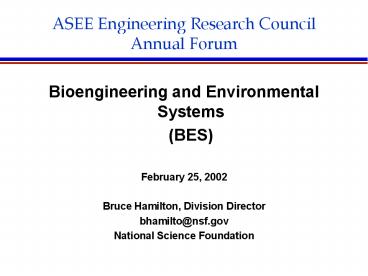ASEE Engineering Research Council Annual Forum PowerPoint PPT Presentation
1 / 16
Title: ASEE Engineering Research Council Annual Forum
1
ASEE Engineering Research Council Annual Forum
- Bioengineering and Environmental Systems
- (BES)
- February 25, 2002
- Bruce Hamilton, Division Director
- bhamilto_at_nsf.gov
- National Science Foundation
2
Bioengineering and EnvironmentalSystems (BES)
BES MISSION
- Support Both
- Innovative Research and Education
- in
- Bioengineering Environmental Engineering
3
Bioengineering and EnvironmentalSystems (BES)
BES has 3 disciplinary clusters, each funded
at around 1/3 of BESs total of about 42
million/year (FY 2002)
- Biochemical Engineering
- Biomedical Engineering
- Environmental Engineering
4
Bioengineering and Environmental Systems
(BES)BES PRIORITY AREAS
- (1) Tissue Engineering
- (2) Metabolic Engineering
- (3) Post-Genomic QSB
- (4) Nanobiotech
- (5) MUSES
- (6) Biophotonics
(with EEC, MATES, WTEC) (with BIO, MPS,
MEWG) (with ENG, BE) (with NNI) (with ENG,
BE) (with ECS, DARPA, NIH)
5
KEY FEATURESof BES Priority Areas
Example (s) Post-Genomic QSB MATES,
MEWG WTEC (e.g., TE study) CAREER, PECASE
- Key Feature
- (1) Built on Cutting Edge Science
- (2) Leadership of Multi-Agency Cooperation
- (3) Global Perspective
- (4) Diverse, Young PIs
6
PECASE Presidential Early Career Awards
BES PECASE awardees 2000 Garrick Louis, Univ.
of Virginia Anne Robinson, Univ. of
Delaware 2001 Karen Burg, Clemson Univ. Linda
Weavers, Ohio State Univ.
7
CAREER Faculty Early Career Development Program
- Supports career development of junior faculty
- Provides in a single program the support of both
research and education - Each year, BES devotes a very significant portion
of its budget to CAREER awards
8
Nanotechnology and BES
Nanotechnology is being allocated an increasing
portion of BESs annual budget 2000 1.89
million 2001 3.75 million 2002 6.67
million
9
NanobiotechnologyBiosystems at Nanoscale
- Nanobiotechnology is defined as the study and
control of structure-function in biological
systems and processes at the nanoscale. - Two of the grand challenges in Nanoscale Science
and Engineering in which BES/ENG has strong
interest are - Advanced healthcare, therapeutics and diagnostics
and - Nanoscale processes for environmental improvement
DNA molecules are about 2.5 nanometers wide. Ten
hydrogen atoms span 1 nanometer. (Credit Liz
Carroll)
10
BES and MUSES
MUSES Materials Use Science, Engineering
Society. MUSES is a new topic this year. Part
of the NSF-wide priority, Biocomplexity in the
Environment (BE)
11
BES and MUSES
MUSES calls for interdisciplinary proposals that
cover both Technological issues (such as
environmentally benign process redesign and
manufacturing, and Behavioral factors (such as
economic and other social forces that affect
consumption and adoption of new technologies and
materials).
12
BES and MUSES
2002 Planning Grants (up to 100,000) 2003 Gr
oup Research and Education Grants
13
BES and MUSES
- Due date for MUSES planning grant proposals
March 14, 2002 - Find out more at the BE website on NSFs homepage
at - www.nsf.gov
14
BES and Biophotonics
- BES has led the formation of the Interagency
Biophotonics Partnership (NSF, NIH, DARPA so
far). - Annual Biophotonics grant competition, currently
round 3.
15
BES and Biophotonics
- Due date for Biophotonics proposals is Feb. 25,
2002. - Find out more by looking at the Biophotonics
Partnership solicitation posted on the BES
website on NSFs homepage.
16
BES
- Biochemical Engineering
- Biomedical Engineering
- Environmental Engineering

